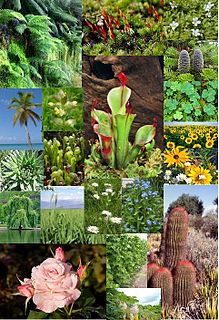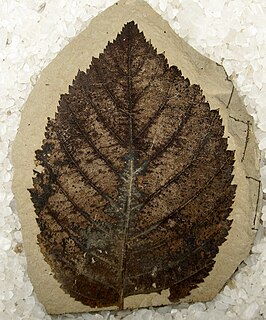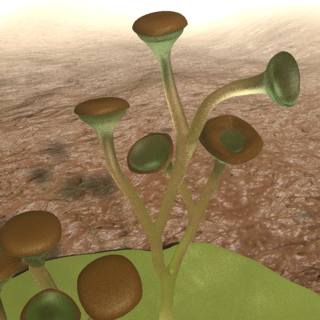
The Devonian is a geologic period and system of the Paleozoic, spanning 60.3 million years from the end of the Silurian, 419.2 million years ago (Mya), to the beginning of the Carboniferous, 358.9 Mya. It is named after Devon, England, where rocks from this period were first studied.

The Embryophyta, or land plants, are the most familiar group of green plants that comprise vegetation on Earth. Embryophyta is a clade within the Phragmoplastophyta, a larger clade that also includes several green algae groups, and within this large clade the embryophytes are sister to the Zygnematophyceae/Mesotaeniaceae and consist of the bryophytes plus the polysporangiophytes. Living embryophytes therefore include hornworts, liverworts, mosses, lycophytes, ferns, gymnosperms and flowering plants.

A transitional fossil is any fossilized remains of a life form that exhibits traits common to both an ancestral group and its derived descendant group. This is especially important where the descendant group is sharply differentiated by gross anatomy and mode of living from the ancestral group. These fossils serve as a reminder that taxonomic divisions are human constructs that have been imposed in hindsight on a continuum of variation. Because of the incompleteness of the fossil record, there is usually no way to know exactly how close a transitional fossil is to the point of divergence. Therefore, it cannot be assumed that transitional fossils are direct ancestors of more recent groups, though they are frequently used as models for such ancestors.

Paleobotany, which is also spelled as palaeobotany, is the branch of botany dealing with the recovery and identification of plant remains from geological contexts, and their use for the biological reconstruction of past environments (paleogeography), and the evolutionary history of plants, with a bearing upon the evolution of life in general. A synonym is paleophytology. It is a component of paleontology and paleobiology. The prefix palaeo- means "ancient, old", and is derived from the Greek adjective παλαιός, palaios. Paleobotany includes the study of terrestrial plant fossils, as well as the study of prehistoric marine photoautotrophs, such as photosynthetic algae, seaweeds or kelp. A closely related field is palynology, which is the study of fossilized and extant spores and pollen.

Cooksonia is an extinct group of primitive land plants, treated as a genus, although probably not monophyletic. The earliest Cooksonia date from the middle of the Silurian ; the group continued to be an important component of the flora until the end of the Early Devonian, a total time span of 433 to 393 million years ago. While Cooksonia fossils are distributed globally, most type specimens come from Britain, where they were first discovered in 1937. Cooksonia includes the oldest known plant to have a stem with vascular tissue and is thus a transitional form between the primitive non-vascular bryophytes and the vascular plants.
Cryptospores are fossilised primitive plant spores that first appear in the fossil record during the middle of the Ordovician period.

Wattieza was a genus of prehistoric trees that existed in the mid-Devonian that belong to the cladoxylopsids, close relatives of the modern ferns and horsetails. The 2005 discovery in Schoharie County, New York, of fossils from the Middle Devonian about 385 million years ago united the crown of Wattieza to a root and trunk known since 1870. The fossilized grove of "Gilboa stumps" discovered at Gilboa, New York, were described as Eospermatopteris, though the complete plant remained unknown. These fossils have been described as the earliest known trees, standing 8 m (26 ft) or more tall, resembling the unrelated modern tree fern.

The evolution of plants has resulted in a wide range of complexity, from the earliest algal mats, through multicellular marine and freshwater green algae, terrestrial bryophytes, lycopods and ferns, to the complex gymnosperms and angiosperms of today. While many of the earliest groups continue to thrive, as exemplified by red and green algae in marine environments, more recently derived groups have displaced previously ecologically dominant ones; for example, the ascendance of flowering plants over gymnosperms in terrestrial environments.

Psilophyton is a genus of extinct vascular plants. Described in 1859, it was one of the first fossil plants to be found which was of Devonian age. Specimens have been found in northern Maine, USA; Gaspé Bay, Quebec and New Brunswick, Canada; the Czech Republic; and Yunnan, China. Plants lacked leaves or true roots; spore-forming organs or sporangia were borne on the ends of branched clusters. It is significantly more complex than some other plants of comparable age and is thought to be part of the group from within which the modern ferns and seed plants evolved.

Polysporangiophytes, also called polysporangiates or formally Polysporangiophyta, are plants in which the spore-bearing generation (sporophyte) has branching stems (axes) that bear sporangia. The name literally means many sporangia plant. The clade includes all land plants (embryophytes) except for the bryophytes whose sporophytes are normally unbranched, even if a few exceptional cases occur. While the definition is independent of the presence of vascular tissue, all living polysporangiophytes also have vascular tissue, i.e., are vascular plants or tracheophytes. Extinct polysporangiophytes are known that have no vascular tissue, and so are not tracheophytes.

Pertica is a genus of extinct vascular plants of the Early to Middle Devonian. It has been placed in the "trimerophytes", a strongly paraphyletic group of early members of the lineage leading to modern ferns and seed plants.

The spermatophytes, also known as phanerogams or phaenogams, comprise those plants that produce seeds, hence the alternative name seed plants. They are a subset of the embryophytes or land plants.
Sartilmania is a genus of extinct vascular plants of the Early Devonian. Fossils were found on the Sart Tilman campus of the University of Liège, Belgium.

Aarabia is a genus of extinct vascular plants found in central Morocco in outcrops of Early Devonian age. The leafless plant has a complex branching system with a main stem and at least three orders of side branches. In addition to these long branches, stems bore very short branches, which typically branched once into two curved sections. Spore-forming organs or sporangia were borne singly on reduced lateral branches in groups of at least three. The genus is thought to be related to the euphyllophytes – modern ferns and seed plants.
Aberlemnia is a genus of extinct vascular plants of the Early Devonian, which consisted of leafless stems with terminal spore-forming organs (sporangia). Fossils found in Scotland were initially described as Cooksonia caledonica. A later review, which included new and more complete fossils from Brazil, showed that the specimens did not fit the circumscription of the genus Cooksonia; accordingly a new genus Aberlemnia was proposed.
Psilophytites is a form genus of extinct plants; it was created by Høeg for spiny stems (axes) which cannot be assigned to a more precise genus or species, usually because spore-forming organs or sporangia are not present.

Taeniocrada is a genus of extinct plants of Devonian age. It is used as a form genus for fossil plants with leafless flattened stems which divided dichotomously and had prominent midribs regarded as containing vascular tissues. It has been suggested that some species assigned to this genus were aquatic.

Aneurophyton is a genus of extinct vascular plants that belong to the Aneurophytales, a class of progymnosperms. The genus is primarily known from records of two well-known species found in mostly Middle Devonian and Upper Devonian outcrops in Belgium, China, Germany, and the United States. Some uncertain species within the genus are also recorded from Middle Devonian outcrops in Kazakhstan, Russia, and the Ukraine. While a number of species have been described in the paleobotanical literature, the genus likely only contains two well-circumscribed species, A. germanicum and A. doui, and possibly a third species, A. olnense, from Fammenian outcrops in Belgium. If the ages of the Early Devonian (Emsian) records of A. germanicum reported from Siberia are confirmed, these would constitute the oldest records of this genus.
Franhueberia is an extinct monospecific genus of vascular land plants described from Early Devonian outcrops of the Battery Point Formation along the south shore of Gaspé Bay, Quebec, Canada.
Philippe Steemans is a Belgian geologist researcher, best known for his work on palynology. As a Senior Researcher of the National Fund for Scientific Research (NFSR) at the University of Liège, Belgium, in the Department of Geology, Steemans studies fossilised spores from Palaeozoic, mainly from their first occurrence in the Ordovician up to the Devonian.














